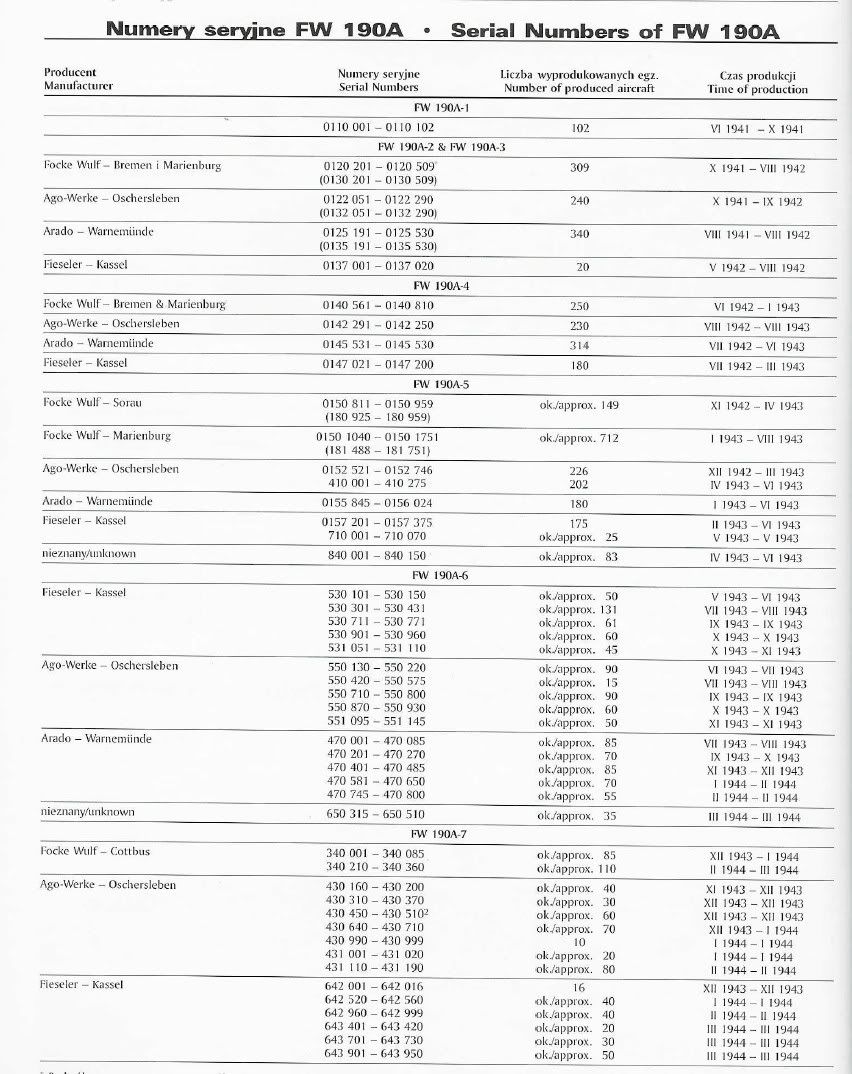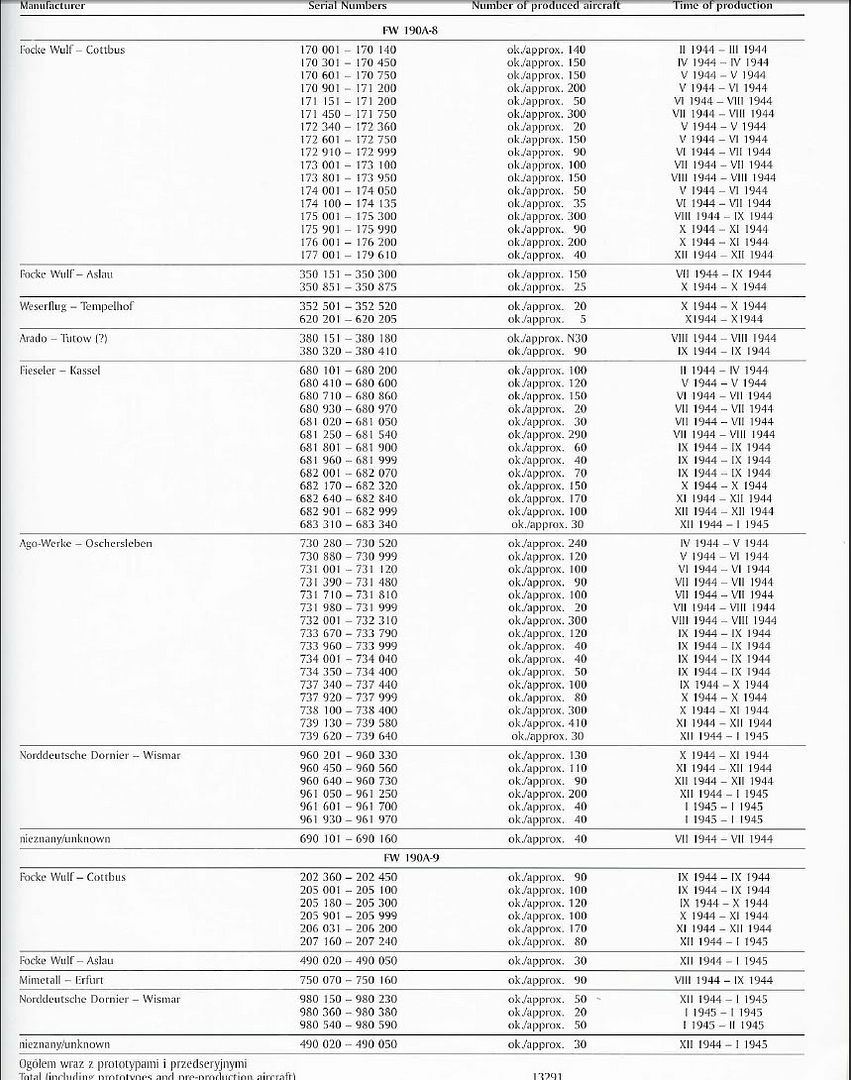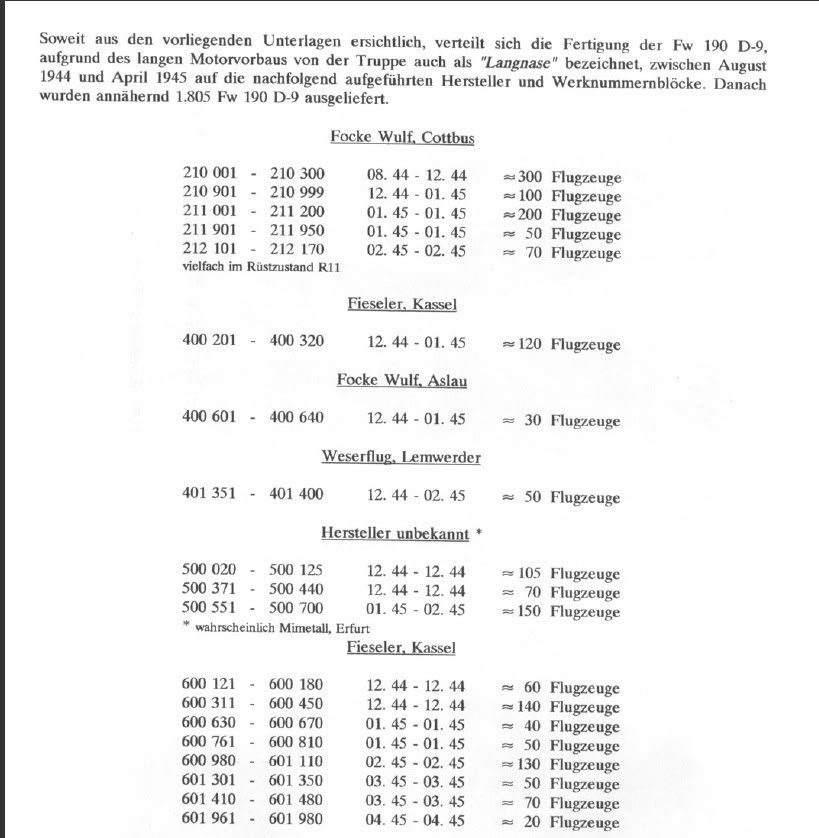
 |
|
#171
|
||||
|
||||
|
Quote:
  your link for 1805 dora 9's seems correct  Safe to say that the Dora 9 was not the most produced 190, lol. got the numbers for other doras and Ta's as well, if anyones interested. Last edited by fruitbat; 01-24-2011 at 02:10 PM. |
|
#172
|
|||
|
|||
|
S!
Some 1705 produced FW190D-9 is not a small number. Rather the amount 830 airframes of FW190A-9 is, comparable to a few tens more of FW190A-4's built. FW190A-8 seems to be the most produced and used version according to that table When looking at the figures of relative performance between Spitfire and Fw190A one can easily see that if the speed difference was within 5-15km/h then a worn out plane or wrongly trimmed plane, for example, would make you lose to the other in performance, be it the Spit or Focke-Wulf. Down to the pilot skill more or less when talking of so small speed margins seen here. IF a Spitfire flies 550km/h and Fw190A 545km/h at a certain altitude it does not make the Spitfire "superior" or "overwhelmingly good" over the FW..or vice versa. The planes could have different performance for various reasons. Blindly quoting and touting stuff like a fanboi, as seen in this thread, is useless. IF planes are so evenly matched the rest really boils down to the pilot skill and the situation. Fw190 and Spitfire were remarkable planes, but had their weaknesses and required a skilled pilot for best results. |
|
#173
|
||||
|
||||
|
Quote:
you know thats far to much sense for this thread flanker, |
|
#174
|
|||
|
|||
|
Without doubt, I completely agree.
|
|
#175
|
|||
|
|||
|
Quote:
|
|
#176
|
||||
|
||||
|
hello troll.
|
|
#177
|
|||
|
|||
|
First of all and since it's been already brought up twice, i don't see how the amount of available pilots has anything to do with how good the D-9 was, or any other warplane for that regard. The 262 didn't have much of an impact, yet nobody can argue it wasn't revolutionary and keep a straight face while doing so. In a similar fashion, was the B-17 a rubbish bomber because they lost 60 of them on the Schweinfurt raid due to awful planning? Not by a long shot i'd say
What i'm trying to say is we're discussing flight models which means how the aircraft fly, not if they were flown by experten and their impact on the war's outcome. It's true that when referencing pilot narratives they will be tinted by their personal perception and experience (one man's crappy plane is another man's ace maker, within limits of course and owing to how each pilot prefers to fly and the tactics he likes to use), but i see the knowledgeable folks have started digging up the numbers so we've already sidestepped that issue. How many pilots flew it or how many of them knew what they were doing has just nothing to do with how good or bad of an aircraft the D-9 actually was. Let's not try to diminish the design and engineering value of an aircraft that gives us trouble in the sim based on how outside situational factors limited its performance, just saying Now, as for the actual numbers i think i'll agree with this: Quote:
Finally a recent observation about the negative G issue, which this post reminded me about: Quote:
I don't remember if it's in this very thread, but i sat through the entire BBC documentary about the battle of Britain that someone linked on youtube and at one point a surviving RAF veteran (i think it was Tom Neil) talks about the advantages and disadvantages of Spit vs 109. Well lo and behold, according to that guy the reason for the loss of power is not the engine cutting out from fuel starvation, but having too much fuel! In a negative G maneuver the float in the carburetor would be pushed upwards due to inertia. However, when describing how the float carburetor actually worked he said that in order to get more fuel to the engine the float mechanism moved up, not down. Putting two and two together, the conclusion is that negative G maneuvers didn't cause fuel starvation but an over-rich mixture, that "drowned" the engine and resulted in minimal power being developed. There was enough fuel to keep it running (obviously), but it was burned inefficiently and didn't produce any real power. The pilot in the video also mentions how "massive, enormous clouds of black smoke would come out of the exhaust", which is a telltale sign of unburnt fuel and too rich a mixture. He also mentions how this could go on for "three, four or five seconds" during a diving chase with no mention of the engine quitting, which further corroborates the assumption that loss of power results mainly from too much fuel instead of not enough of it. Bottom line, the engine doesn't stop running but it's still not developing power anyway. Now i'm not a real life pilot but whatever virtual flying i've done in civilian sims and most real life manuals for general aviation aircraft i've read, agree that the engine loses power when running on too rich a mixture but doesn't necessarily quit altogether. In fact, for many general aviation aircraft part of the descent checklist before landing is to go to full rich mixture if idling below a certain RPM value, in order to be already setup for the landing circuit and since minimal power is needed during the descent phase, plus to safeguard against overheat or even accidental stoppage. The mixture control limits fuel flow but so does using a lower throttle setting after a certain threshold. So if you run a cessna at idle with a lean mixture during the descent, you could possibly get high cylinder head temps due to not enough fuel in the cylinders plus an accidental fuel starvation and the engine quitting. Enriching the mixture to full rich prevents his, the engine loses power but it's ok since we want to descent anyway, plus the pilot's attention doesn't need to be focused on incrementally finding the correct mixture setting every few thousand feet he descents, he just sets it for low level where the landing circuit will be flown and leaves it there. If there was any danger of the engine quitting as a result of a rich mixture, i assume it wouldn't be something the manufacturer's checklist would tell the pilot to do on such a critical phase as the landing approach. So, if we sum everything up we get the conclusion that when applying negative G maneuvers the carb fed merlin engine shouldn't suffer from fuel starvation and shouldn't quit, but it should run rough on too rich a mixture and just not produce enough power. Mind you, that's for the initial push of the stick forward that forces the float in the carb to go up. I don't know if fuel starvation really does set in when in a prolonged inverted flight situation, which would be very possible if the containter where the float is situated is gravity fed. The end result might still be the same (a 109 that gains separation through an evasive dive), but it explains the youtube video of the Spit's test flight. In the video the engine doesn't quit because it has as much fuel as it needs to keep running and then some for the short duration of the inverted pass, it just doesn't make good power as a result of too much fuel in the mixture. So, how is the maneuver flown then? I'll have to rewatch it to be absolutely sure so correct me if i'm wrong, but i think i remember the inverted pass being flown after a dive. This probably gives the Spit in the test flight video enough speed for an inverted pass of a mere few seconds. Why doesn't it emit black smoke from unburnt fuel? I'm not an expert by any means, but i can still think of a few plausible reasons: 1) The pass is practically at ground level, where engines can run with a richer mixture. This could mean that during the initial negative G phase, the lower you are the less power you lose from the overly rich mixture. If it needs X fuel flow at sea level, X-10 at 20000 feet and a -3G maneuver pushes X+20 fuel flow into the engine, it's easy to see that at 20000 feet the resulting fuel flow from the same maneuver is 30 fuel flow units higher than optimal, but at sea level it's only 20 fuel flow units higher than optimal. 2) He's a test pilot and has a few tricks up his sleeve. Namely, when making a pass for the cameras it's not good to have the aircraft belching thick black smoke, so pick up some extra speed first in the dive to make it through the maneuver and when you roll inverted and start pushing negatives, reduce throttle to idle to reduce fuel flow and minimize the chance of smoke appearing, coasting through the pass on kinetic energy alone accumulated in the dive. Then roll upright again, re-apply power and off you go. Long story short, just because the engine is running doesn't mean it's of any real use under a certain set of circumstances. What we don't know is how pronounced these circumstances were. In light of Tom Neil's interview i too think that the engines in the sim quit a bit too easily, but i still think that a carb fed Spit without the Shilling modification probably wouldn't be able to follow a BF-109 in a negative G maneuver. Loss of power is loss of power, whether is due to fuel starvation or improperly rich mixture. |
|
#178
|
||||
|
||||
|
Nice one Blackdog_kt first long one of yours in a while that hasn't been a struggle to read.
I wonder whether the I-16 was similar? |
|
#179
|
|||
|
|||
|
Hmmm... FM discussions. Have you ever noticed that most times it's only about turning performance or speed? As if these were the only variables that mattered.
That's the result of IL2 playing: It's the only reality we know Let's hope that COD will introduce other things we will have to worry about in combat. Complex engine management for exemple. At the moment you can hit the W-key leave everything on 100% and you are ready to go. There is no advantage having the Kommandogerät or other automatic devices. Should be interesting to see how COD will increase the workload in the cockpit. This should slightly change things. For exemple:Having a slight advantage in speed or turn will not make your plane supperior, because maybe the other guy can handle prop pitch etc. better then you. Or more engine failures due to improper engine management. I am looking forward to all this (if it's in the game) |
|
#180
|
||||
|
||||
|
Blackdog_kt you have probably right. Most opinions and data claim that float curraburator under negative G casue engine stall due to fuel lost but probably the truth is that lost power is beacuse of fuel flood curraburator and engine. When you apply negative G float in curraburator is going up and fuel flood curraburator. Probably with prolonged fuel flood engine could stop and then could be little problem with start it again. Of course moving prop will start engine again but it could need some time to do it.
I have a few time problem to start on ground inline engine of plane beacuse i gave it too much mixture. I think Ms Shilling Oriffice was a small disc with hole to prevent fuel flood curraburator. Ad to video with Spitfire flying aerobatic when he is making inverting flying he is actually in shallow dive with throttle back. JG4_Helofly Spits or Hurricanes from BOB era have not too much engine workload. You opearated mostly throttle level beacuse you got CSP ( constant speed propeller unit) which mean that you just set only wanted RPM ( in fight maximum possible, in cruise depend of economy of fuel) and mixture level was also only for economical flying ( auto - reach - lean). Much more work load have planes with variable prop pitch like early 109s and early russian planes. Last edited by Kwiatek; 01-24-2011 at 04:58 PM. |
 |
|
|